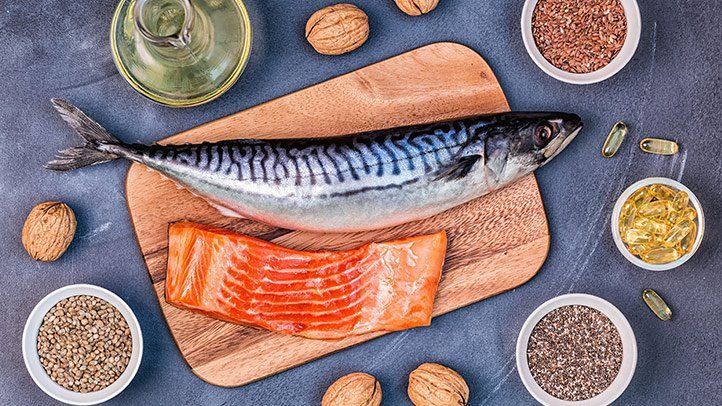- Empty cart.
- Continue Shopping
How to Choose the Right Types of Fish for Omega-3s

Omega-3 fatty acids are essential nutrients that offer a myriad of health benefits, from supporting heart health to improving cognitive function. While omega-3 supplements are readily available, one of the best natural sources of these fatty acids is fish. However, not all fish are created equal when it comes to omega-3 content, and choosing the right types of fish is crucial for reaping the nutritional benefits.
Understanding Omega-3 Fatty Acids
Before diving into fish selection, it’s essential to understand the different types of omega-3 fatty acids and their health benefits. The three primary omega-3 fatty acids are:
- Eicosapentaenoic acid (EPA): Known for its anti-inflammatory properties, EPA is vital for cardiovascular health, reducing triglyceride levels, and supporting mental health.
- Docosahexaenoic acid (DHA): DHA is crucial for brain development, cognitive function, and maintaining healthy vision. It is also beneficial for heart health.
- Alpha-linolenic acid (ALA): While ALA is essential, it is primarily found in plant-based sources like flaxseeds, chia seeds, and walnuts. It can be converted into EPA and DHA in the body, but this conversion is relatively inefficient.
For maximum health benefits, it’s recommended to consume both EPA and DHA directly from dietary sources, such as fish.
Factors to Consider When Choosing Fish
When selecting fish for their omega-3 content, several factors come into play:
1. Fish Species
Different fish species contain varying levels of omega-3s. Fatty fish, such as salmon, mackerel, sardines, and trout, are renowned for their high omega-3 content. These fish are top choices for boosting your intake of EPA and DHA.
2. Wild vs. Farmed
The source of the fish can significantly impact its omega-3 content. Wild-caught fish generally have higher omega-3 levels than their farmed counterparts. This is because wild fish feed on a natural diet rich in marine organisms that contain omega-3s. Farmed fish may have lower omega-3 levels due to differences in their diet.
3. Processing Methods
The way fish is processed can affect its omega-3 content. Fresh, frozen, and canned fish can all be excellent sources of omega-3s, but it’s important to check labels for additives like salt or unhealthy fats, which can diminish the health benefits.
4. Sustainability
Sustainability is a vital consideration when choosing fish. Opt for fish that are sourced sustainably to support healthy marine ecosystems. Look for certifications like the Marine Stewardship Council (MSC) or the Aquaculture Stewardship Council (ASC) on the packaging.
Top Omega-3-Rich Fish Options
Now that you know what to look for let’s explore some of the best fish options for omega-3s:
1. Salmon
Salmon is often considered the king of omega-3-rich fish. It is abundant in both EPA and DHA. Wild-caught salmon, in particular, is an excellent choice for those seeking maximum omega-3 benefits. Whether grilled, baked, or pan-seared, salmon is a delicious and nutritious option.
2. Mackerel
Mackerel is another fatty fish packed with omega-3s. It’s especially high in both EPA and DHA. While mackerel is a flavorful fish, it has a stronger taste compared to salmon and may not be to everyone’s liking.
3. Sardines
Sardines are a small, oily fish that’s big on omega-3s. They’re rich in both EPA and DHA and are also a great source of calcium due to their edible bones. Canned sardines are a convenient and budget-friendly option.
4. Trout
Rainbow trout, in particular, is known for its omega-3 content. It’s a versatile fish that can be grilled, broiled, or baked. Like salmon, trout is readily available and well-suited to various culinary preparations.
5. Herring
Herring is often overlooked but deserves a place on your omega-3-rich fish list. It contains a substantial amount of EPA and DHA and can be enjoyed smoked, pickled, or as a fillet.
Incorporating Omega-3-Rich Fish Into Your Diet
Now that you know which fish to choose, here are some tips for incorporating them into your diet:
1. Regular Consumption
Make a conscious effort to include omega-3-rich fish in your diet at least twice a week to ensure a consistent intake of these essential fatty acids.
2. Variety Is Key
Don’t limit yourself to just one type of fish. Incorporate a variety of omega-3-rich fish into your meals to diversify your nutrient intake and keep your taste buds excited.
3. Healthy Cooking Methods
Opt for healthier cooking methods like grilling, baking, or steaming to preserve the nutritional value of the fish. Avoid deep-frying or excessive use of butter or oil.
4. Omega-3 Supplements
If you have dietary restrictions or find it challenging to consume enough omega-3-rich fish, consider omega-3 supplements. However, consult with a healthcare professional before adding supplements to your routine.
In Conclusion, Selecting the right types of fish for omega-3s is a smart and delicious way to support your overall health. By considering factors such as fish species, source, processing methods, and sustainability, you can make informed choices that benefit both your well-being and the environment. So, next time you’re at the seafood counter or perusing a restaurant menu, remember to prioritize omega-3-rich fish for a tasty and nutritious meal. Your body and brain will thank you for it.








